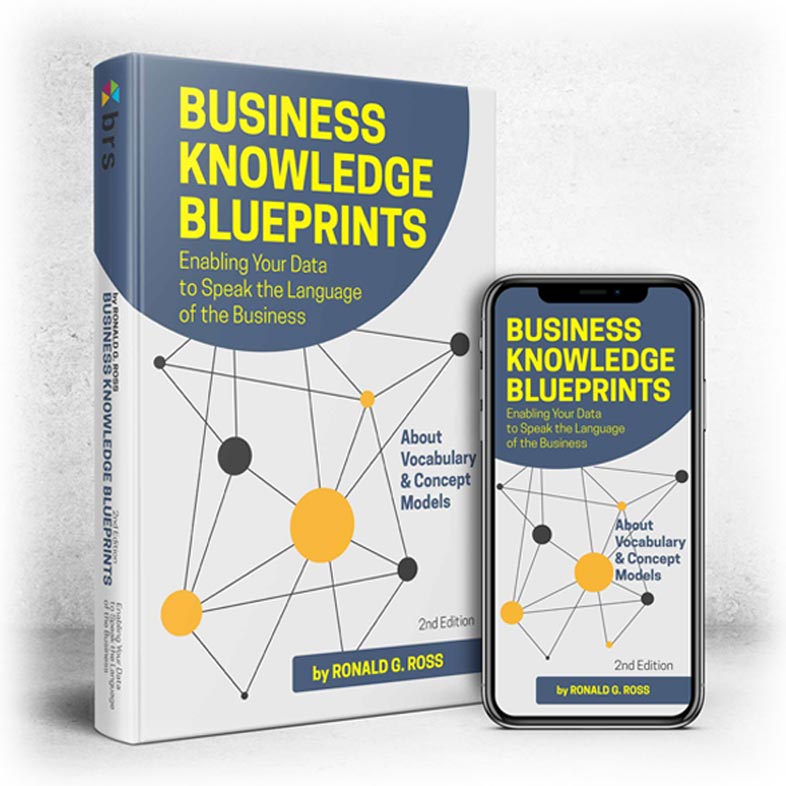Business Knowledge Blueprints By Ronald G. Ross
Finally, the Go-To Handbook for Building Shared Understanding
Here’s everything you need to know about
- Developing business vocabularies.
- Defining terms.
- Disambiguating concepts.
More than that, this handbook shows you how to clarify the meaning of everyday business communication and put business clarity into your data.

Introducing Concept Models
A concept model gives you a way to talk with subject matter experts in a way you’ve never had before. It will:
- Guide you in asking the right questions.
- Help you achieve business clarity.
- Show you how the pieces all fit together.
- Make you sound smart.
What about data? This book is for those intimidated by data, for those whose companies have poor quality data, or for those in initiatives seeking to tap into the power behind the data. Learn these techniques and you’ll ‘do’ all forms of data far better.
So many people these days – including business managers – know in their guts something is amiss about current approaches. Something in IT and data is simply not adding up. Not some small thing, but a very big thing. Data quality is awful. Systems still fail to meet expectations due to inadequate or misdirected requirements. Customer expectations simply aren’t being met. Now we are plunging headlong into a world of bots, AI, blockchain and more, with little or no sense of what it will really take to get us there.
If you are one of those people, this book provides the insights you need to talk directly about the problem – as well as all the robust techniques needed to tackle it head-on.
Who is this book for?
Think of a concept model as the new Knowledge Commons for the business. It’s about getting everyone on the same page for Knowledge-Age success!
- Business People: governance, risk and compliance managers, regulators and policy makers, legal staff, knowledge managers, product designers, and training managers
- Transformation Professionals: business analysts, business architects, data scientists, data modelers, and software professionals who support the business
Paperback – $19.95
Kindle – $9.95
Here’s What Readers Are Saying
Find out what readers have been saying about Business Knowledge Blueprints.
“ A great book. Definitely a topic more people in data should be concerned about. There is so much rapid...
Winfried Adalbert Etzel
“ ... thank you for writing Business Knowledge Blueprints. It's a wonderful book. As a seasoned data modeler it has...
Andrew Foad
“Excellent, practical, useable." “This is a really clear, practical book which is clearly based on a huge amount of practitioner...
Adrian Reed
“ ... really enjoyed your book, both for the actual content and the good writing."
Christian Kaul
“... one of the most useful and engaging books I've come across in a while. It's full of highlights, underscores...
Monique Kebbe
“Love this book, and the others you have written Ron, big fan and believer all the way over in New...
Kim Wilson
“Anyone even only thinking about deploying business models that rely heavily on data should take note."
Thomas Olbrich
“I love your concept models! Incredibly powerful."
Peter O'Donoghue
“A great book for those of us wearing a zillion hats on how to get more done in less time...
Tina Underhill
“In this book Ron Ross pulls apart business communications, shows how easily it can be a mess, shows how that...
Roger Tregear
“I have realized that my point of view is still closer to technical-oriented by reading your book. Thank you for...
Kwangchul Shin, Ph.D
“Just finished reading this wonderful book. I can’t recommend it highly enough – and not just to fellow business architects/analysts....
James Shields
“Really like the book. Very useful and understandable.”
Jan Mark Pleijsant
“Very good … has already helped a project that I’m on. Those of you in business analysis and/or data should...
Gary Rush
“a great contribution to unify business communication”
Fabricio Laguna
"Anyone working closely with data, especially business and data analysts and architects, would benefit from the thought leadership and practical...
Dora Boussias
"The ideas in this book are a big part of the answer to ‘the black box’ and transparency around automation....
John Morris
"Our ability to understand each other is only as good as the definition we share on each word."
Mark Meyers
"[Concept models are] a great way for stakeholders to understand the impact of the change they’re considering."
Michelle Murray
"Part V on how to create business definitions is the best. The examples are great.”
Nick Vaughan
"Well done! This is the book I’ve been wanting for years. Now people can truly apply SBVR for real-world problems."
Keri Anderson Healy
"You need precision and consistency in every business communication. The more you focus on it, the more you will see...
Gladys S.W. Lam
"Excellent subject, well written, very timely book. … a strong contribution to a missing dimension for business architects."
Ramsay Millar
"An extremely valuable book for practitioners of business analysis. Excellent presentation of such a complex subject matter as concept modeling...
David Lyalin
"A solid guide. Concept models are essential for creating the building blocks of the Knowledge Age. Welcome to the future!”
Robert Dizinno
"Let me congratulate you on an excellent book, that should help others design better models."
Terry Halpin
Donald Chapin
...Terry Halpin
...Robert Dizinno
...David Lyalin
...Contents
Preface
Part I: Introduction
Chapter 1: Why Business Concept Models
Chapter 2: The Four Dimensions of Communication Clarity
Chapter 3: What Concept Models Are About
Chapter 4: Creating Concept Models
Part II: Getting to Know the Things You Talk About
Chapter 5: Distinguishing Things
Chapter 6: Naming Things
Chapter 7: Defining Things
Chapter 8: Disambiguating Things
Part III: Standard Relations
Chapter 9: Classifications
Chapter 10: Categorizations
Part IV: Verb Concepts
Chapter 11: Verb Concepts and Wordings
Chapter 12: Nouns Based on Verbs
Chapter 13: Verb Concept Structures
Chapter 14: Verbs and Transformations
Part V: How to Define Business Terms in Plain English
Chapter 15: The Kick-Off of a Definition
Chapter 16: The Main Body of a Definition
Chapter 17: Sets of Definitions
Conclusion
Appendix 1: Conceptual Model vs Concept Model: Not the Same!
Appendix 2: Data Model vs Concept Model: Not the Same!
Appendix 3: EU-Rent Example
Glossary
Index
Who is Ron Ross
Ron is one of the world’s foremost authorities on both structured and unstructured data. He is Co-Founder and Principal of Business Rule Solutions, LLC (BRS). At BRS, he has helped create concept models at hundreds of companies and government bodies.
Ron is Chair of Building Business Capabilities (BBC), the official conference of the International Institute of Business Analysis (IIBA®). He is best known for his industry-leading work on business rules, and before that, for his contributions in the field of data design and database. He was a founder and is a principal in standards work at OMG on SBVR (Semantics of Business Vocabulary and Business Rules), the ground-breaking standard behind concept models.
Ron has keynoted dozens of conferences and given seminars to many thousands of people worldwide. He is currently Executive Editor of BRCommunity.com and its flagship on-line publication, Business Rules Journal. Ron is recognized internationally as the ‘father of business rules.’
Ron is the author of ten professional books including the first on data dictionaries and data administration in 1981. Books on business rules include the classic Business Rule Concepts: Getting to the Point of Knowledge4th ed. (2013) and Building Business Solutions: Business Analysis with Business Rules 2nd ed. with Gladys S.W. Lam (2015). He is co-author with John Zachman and Roger Burlton of the 2017 Business Agility Manifesto.
Ron received DAMA International’s Individual Achievement Award for 1995. He was formerly Editor of the Data Base Newsletter from 1977 to 1998. Ron holds an M.S. in information science from the Illinois Institute of Technology and a B.A. from Rice University.



